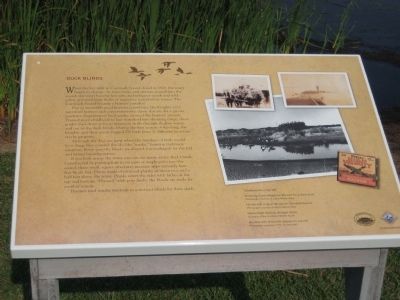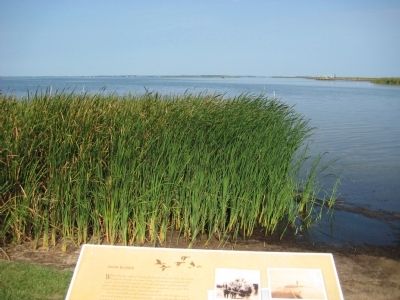Corolla in Currituck County, North Carolina — The American South (South Atlantic)
Duck Blinds
Due to incredibly good hunting conditions, the Knights, avid waterfowl hunters and conservationist, chose this site for a private residence. Experienced local guides ensured the hunters' success. Trained since childhood to lure waterfowl into shooting range, these guides used shove poles to maneuver skiffs through shallow waters and out to the duck blinds. During the first season of shooting, the Knights and their guests bagged 751 birds from 11 different locations on the property.
Although the days are done when the numbers of birds would be so large they covered the sky like "smoke", hunting traditions continue. Every year the blinds are dressed (camouglaged) for the fall and winter hunting season.
If you look across the water you can see many active duck blinds. Constructed by pushing four to six gum or maple poles into the sound, these small, square structures measure approximately four feet by six feet. Floors made of plywood planks sit about two and a half feet above the water. Planks cover the sides with lathes at the top and bottom. "Dressed" with pine limbs, the blinds are ready for another season.
Hunters used similar methods to construct blinds for their skiffs.
Clockwise from top left:
Dressing (camouflage) on the card for a duck blind. Photograph courtesy of Joyce Gallop Gaus
Hunter with a rig of decoys on Currituck Sound. Photograph courtesy of Joyce Gallop Gaus
Peters High Velocity shotgun shells. Courtesy of the Currituck Wildlife Guild
Hunters with silhouette decoys on a pond.Photograph courtesy of Gin Leinneweber
Erected by Whalehead Club Currituck Heritage Park, Outer Banks Center for Wildlife Education, N.C. Wildlife Resources Commission.
Topics. This historical marker is listed in these topic lists: Entertainment • Environment. A significant historical year for this entry is 1828.
Location. 36° 22.425′ N, 75° 50.002′ W. Marker is in Corolla, North Carolina, in Currituck County. Marker can be reached from the intersection of Ocean Trail (State Highway 12) and Club Road. Marker is within Whalehead Park, about 150 feet southwest of the wooden bridge, about 1/4 west of the entrance to the park. Touch for map. Marker is in this post office area: Corolla NC 27927, United States of America. Touch for directions.
Other nearby markers. At least 8 other markers are within walking distance of this marker. Waterfowl Resting Area (within shouting distance of this marker); Corolla Island Bridges (within shouting distance of this marker); Waterfowl Hunting (within shouting distance of this marker); The Whalehead Club Restoration (about 300 feet away, measured in a direct line); The Whalehead Club (about 400 feet away); Ray T. Adam's Landing Strip (about 400 feet away); A Nation's Defense (about 500 feet away); First Swimming Pool on the Outer Banks (about 600 feet away). Touch for a list and map of all markers in Corolla.
Credits. This page was last revised on June 16, 2016. It was originally submitted on August 24, 2008, by F. Robby of Baltimore, Maryland. This page has been viewed 1,985 times since then and 27 times this year. Photos: 1, 2. submitted on August 24, 2008, by F. Robby of Baltimore, Maryland.

